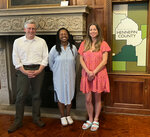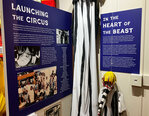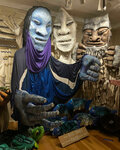




Propped up alongside Sky, Prairie, Moon and Woods and with arms extended, River’s giant, blue face stares down at passersby, perhaps hoping one stops and hears stories about the Mississippi River and its valley.
They are masks that traveled down the river to New Orleans in 1983 with the Heart of the Beast Puppet and Mask Theatre’s Circle of Water Circus troupe as it raised awareness about human disregard for America’s greatest waterway.
Then they went into storage and then nearly a landfill. Until now.
“My purpose was simply to do whatever I could to encourage people to turn their faces to the River again, that had become a sewage line,” recalled Sandy Spieler, who directed the production.
Working with Hennepin History Museum (HHM) curator Alyssa Thiede, these giant mementos of Twin Cities’ cultural and artistic past found a new home and are now on display in the new exhibit “Circle of Water: Puppetry as an Agent of Change.”
Such collaborations align with HHM’s mission “to preserve and explore history, creating spaces where our communities’ stories can be told.”
‘A GEM FOR THE CITY’
According to Meet Minneapolis, the metro area has 55 museums, and HHM sits just north of and not quite in the shadow of its larger cousin, the Minneapolis Institute of Arts on Third Avenue South. Since 1958, it has occupied the former 44-room mansion of Carolyn Christian, who came from lumber and flour milling families who made Minneapolis famous as the “Mill City.”
“It is a gem for the city, I believe. I think it’s a place that people can relate to,” Michele Pollard, the museum’s archivist, said. “I think people come in here and they kind of get this personal relationship with history.”
Unlike larger museums, HHM’s intimate size gives a curator like Theide and executive director John Crippen freedom and agility to take advantage of collaboration opportunities.
“It is serendipitous,” Crippen said. “We get these communities coming to us saying we have a story.” For the museum, those stories must have broader community appeal.
“All three [current] exhibits are curated in collaboration with community members,” Thiede said, empowering them to tell histories in their own way.
“Far Away Home: Tibetans in Minnesota,” which runs through the winter of 2024, highlights a Twin Cities’ community that rarely gets attention, shedding light on this demographic fact: “I learned that we have the second largest Tibetan refugee community in the United States, which was a shock to me,” Thiede said.
“The Bond between Us,” a visual history of Minneapolis from the perspective of three generations of Black photographers, ends Sept. 28. “In Memoriam” replaces it, focusing on the Minneapolis Pioneers and Soldiers Memorial Cemetery, the city’s oldest, recovering stories of the dead buried there.
The museum offers a library for the researcher, who with the help of the archivist, can access the boxes upon boxes of unique archives stored out of sight. “If you are researching individual people, you can find the city directories. If it’s in a neighborhood or district, there’s history on that,” Pollard said.
Even with some county funding, Crippen said he would like have more money to make new hires to ease workload demands on the museum’s six-person staff. For now, they and volunteers keep things running smoothly.
“Our mission is much higher than what our skeleton crew allows,” Thiede said.
“We used to charge $8,” Crippen said. “Now, if you come – for whatever reason you feel it should be free experience – no problem.”
This pay-as-you-can policy has an unexpected upside with many patrons giving on-site donations greater than a regular admission fee, Crippen said. “Many people are happy to react to that pay-as-you-can and say I’m going to help this enterprise move forward,” he said.
While a historic, old city mansion seems an obvious fit for the museum, one serious drawback is that has been difficult to make it accessible for those with mobility issues.
This means taking the museum to the public. “We are not limited by these four walls,” Crippen said, describing a pop-up exhibit at the St. Louis Park Library and a walking tour of the city’s “great swamp areas.”
The “Circle of Water” exhibit is meant to be intergenerational, educating a younger generation about the environmental work of parents and grandparents. “Wow, that’s what they were doing, to work toward water justice and relationships with the environmental. How can that inspire us to do something?” Crippen said.
“Back in 1983, water was a major issue. Why is it still today? Why is water protection still a crisis?” Thiede said.
“History can unite people if you give people a chance to tell their stories,” Crippen said.
For visiting hours and information about the museum visit hennepinhistory.org, keeping in mind there is plenty of free parking.
Comments
No comments on this item Please log in to comment by clicking here